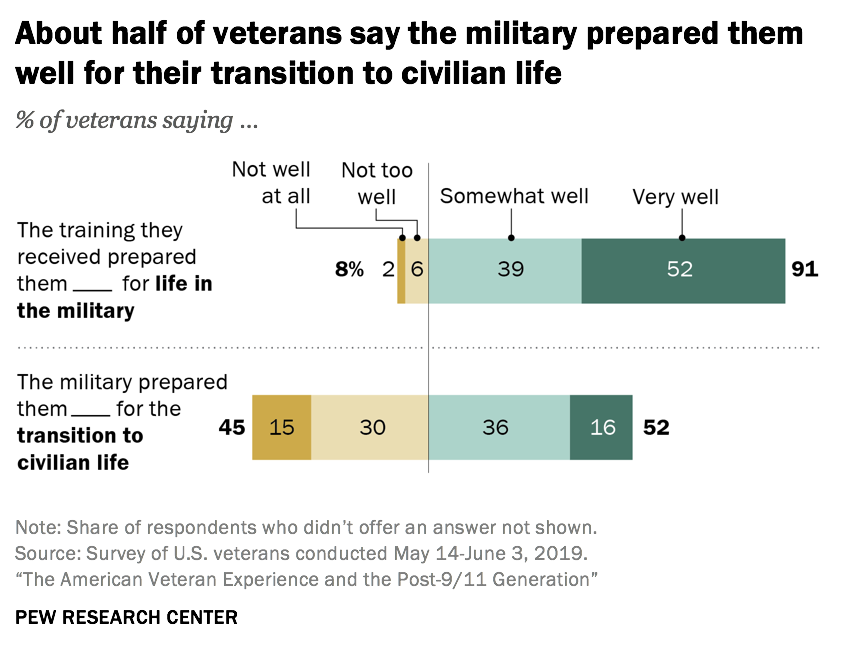Military to Civilian Life Transition
While military service is demanding and challenging, reintegration into society and civilian life also poses challenges. According to Parker et al. (2019), 27% of veterans say that re-entry was difficult for them. Emotionally traumatic experiences in the army contribute to poor quality of life after reentering society. Besides, the risks of poor transition increase with the occurrence of emotionally traumatic experiences in the military. Thus, those who serve in a combat zone and those who have known someone killed in battle are less likely to integrate well. Finally, veterans who are married when serving had a more difficult time readjusting (Parker et al., 2019).
When reentering civilian life after military services, veterans experience a range of emotional challenges. They include difficulty dealing with the new structure of life as civilians and feeling disconnected from friends and family after leaving the military. In addition to emotional issues, veterans encounter financial and health challenges, such as issues getting access to medical care and difficulty paying bills, and the need for unemployment benefits (Parker et al., 2019). As a result of the emotional, socioeconomic, and healthcare challenges, veterans may also struggle with alcohol or substance abuse in the first years after leaving the military (Parker et al., 2019).
Statistics
The readjustment to civilian life comes with many challenges, with the characteristics of life and environment influencing the quality of adjustment to everyday life after the military. For example, the highest impact is caused by the experience of a traumatic event, responsible for 26% (Morin, 2011). 9% of veterans who were seriously injured are less likely to integrate, alongside with 15% post 9/11 veterans and 15% of post 9/11 veteran who was married when serving (Morin, 2011). 7% of individuals who served in combat will readjust badly, alongside 6% of veterans who knew someone who was killed or injured in battle (Morin, 2011).
Following up on the statistics concerning the reintegration into society after the military, half (50%) of military veterans feel unprepared for integrating into civilian life. 57% of all combat veterans personally witnessed someone from their unit to be seriously injured or killed, which contributes to PTSD occurrence and poor reintegration into society. For example, 12.9% is the average incidence of PTSD among US veterans, while the average incidence of PTSD among the general US population is 6.8% (Hill & Ponton, 2017).

PTSD
PTSD is a condition that needs addressing as it is common among military veterans, with 11-30% of individuals who served in the Vietnam War, Gulf War, Operations Iraqi Freedom, and Enduring Freedom diagnosed with it (U.S. Department of Veterans Affairs, 2021). Mike is at extreme risk of developing PTSD due to the breach of lines of resistance, his symptoms include flashbacks, anger outbursts, and problems sleeping, which are consistent with the definition of the disorder (American Psychiatric Association, 2021).
Because Mike is experiencing the symptoms of PTSD, the healthcare challenge must be addressed. It is recommended to implement psychological and pharmacological therapy. Psychological interventions include cognitive-behavioral therapy (CBT), which has the strongest evidence for addressing PTSD symptoms among veterans (Reisman, 2016). Cognitive processing therapy (CPT) and prolonged exposure (PE) are recommended as first-line treatments of PTSD (Reisman, 2016). Besides, Mike should be assessed for suitability of pharmacological therapy to determine whether he should be prescribed Selective Serotonin Reuptake Inhibitors or second-line therapies and alternative pathways.
References
Hill & Ponton. (2017). PTSD and veterans: Breaking down the statistics. Web.
Morin, R. (2011). The difficult transition from military to civilian life. Web.
Parker, K., Igielnik, R., Barroso, A., & Cilluffo, A. (2019). Readjusting to civilian life. Web.
Reisman M. (2016). PTSD Treatment for Veterans: What’s working, what’s new, and what’s next. A Peer-reviewed Journal for Formulary Management, 41(10), 623-634.
